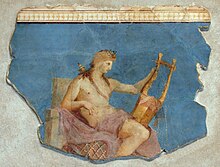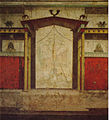House of Augustus
The research calls the House of Augustus ( Latin Domus Augusti , Italian casa di Augusto ) a building complex on the Palatine Hill in Rome , which served as a palatial residence for the first Roman Emperor Augustus .
Building history
The later Augustus acquired the property at the time of the second triumvirate after his naval victory at Naulochus over Sextus Pompeius in 36 BC. It is located on the southwest slope of the Palatine Hill near the site of the supposed hut of the mythical founder of the city, Romulus .
After his election as Pontifex Maximus in 12 BC. Augustus made part of his house a public building so that he did not have to leave his house to exercise this office, as was actually intended for this office. Augustus also set up a Vesta sanctuary in his house because, for cultic reasons, the official residence of the Pontifex Maximus had to be near a Vesta sanctuary .
The multi-storey house is said to have had a rather modest interior compared to the buildings of other nobiles of that time. Instead, Augustus provided his residence with numerous symbolic attributes during his principality , which set it apart from the homes of his fellow senators. Since 27 BC At the entrance to the house , the Senate regularly had two branches of laurel affixed as a symbol of the imperial power of Augustus. At the request of the Senate, an oak wreath (the corona civica ) was placed over the door , which marked it as the “savior of the citizens”. So far, three peristyles have been archaeologically proven in the private wings . You entered the residence either via the temple terrace of Apollo , to do this you had to climb the Palatine Hill from the Circus Maximus , or via a smaller entrance on the Palatine Hill itself. Suetonius writes about the house:
“He [Augustus] initially lived at the Roman Forum, in a house above the stairs of the ring forge, which had previously belonged to the rhetor Calvus, later on the Palatine Hill, but in the no less modest accommodation of Hortensius, which was neither spacious nor luxurious and only had low colonnades with columns made of tuff from the Albanian Mountains and halls without marble stucco and mosaic floors. For more than forty years he used the same bedroom in summer and winter. "
This description could only be partially confirmed archaeologically. Only the northern central part of the house was characterized by restraint and is probably identical to the house of Hortensius. Although the majority of the Augustus house has been completely destroyed, it can still be said that the comparatively large house consisted of a multitude of splendid rooms, which were lavishly furnished with marble and stucco ceilings.
In the immediate vicinity of the house Augustus had imposing buildings erected, including the Temple of Apollo , which was built in 28 BC. Was consecrated, plus a porticus , various meeting rooms and a wide temple forecourt. The great library donated by Augustus, called Palatina , housed the largest collection of books in Rome. In terms of content, it represented a duplicate of the library of Alexandria , to the extent of which the Augustan library was supposedly equal. All these buildings were considered extensions of the house and could not be separated from the actual house.
After Augustus' death, his house was no longer inhabited, but a shrine was set up in its center to commemorate the state god Augustus (Sacrarium Divi Augusti) . At the same time, Livia donated the Ludi Palatini , games in honor of her husband, which verifiably took place on the Palatine Hill, presumably on the site of the Augustus House. The house of Augustus was expanded by the immediate successors from the Julian-Claudian dynasty to include the Domus Tiberiana , a palace complex whose land had already belonged to Augustus and which were originally reserved for members of the imperial family. Under Nero there was the great fire of Rome , as a result of which not only Nero's new palatine residence ( Domus Transitoria ) was destroyed, but also the house of Augustus was very likely to suffer severe damage. The house was probably not restored, but the upper floors were removed and the lower (visible today) filled. The area was redesigned and over its center (the Sacrarium Divi Augusti ) the Caesar temple (templum Divorum or aedes Caesarum) was built to worship the deified couple Augustus and Livia. Under Domitian , the eastern area of the Apollo terrace was redesigned and finally partially surrounded by his imperial palace ( Domus Augustana ) .
Due to the construction of the now no longer existing Caesar temple, some parts of the interior of the house of Augustus are still preserved today. This is probably due to the fact that the said part formed the private living area of Augustus and therefore the original sacrarium was located there. Some of the wall paintings in particular are very well preserved. The paintings on the ground floor have Cybele , the Phrygian mother goddess, as their theme, other rooms are reminiscent of Hellenistic theater sets. They are assigned to the 2nd style, the architectural style, the Roman wall painting . Other paintings in the mask room create a connection to the theater with masks ; Augustus promoted pantomime with the main actor Pylades. The upper floor is dedicated to Apollo with his paintings.
Wall painting in the so-called House of Livia
sightseeing
Since March 10, 2008, some of the rooms in the House of Augustus have been open to the public. However, for conservation reasons, only five people can enter the rooms at the same time, which can lead to longer waiting times. The opening times are linked to the opening of the Palatine Hill, the visit is included in the entrance fee for the Palatine Hill. The House of Augustus only opens at 11:00 a.m. on Mondays.
Since January 15, 2009, the house can only be visited on Mondays, Wednesdays, Saturdays and Sundays from 11.00 a.m. to 3.30 p.m., and it remains closed to the public when it rains.
literature
- Gianfilippo Carettoni: The House of Augustus on the Palatine Hill. Mainz 1983, ISBN 3-8053-0755-1 .
- MA Tomei, The Residence of the First Emperor. The Palatine in Augustan times, in: Adolf Hoffmann , Ulrike Wulf : The Imperial Palaces on the Palatine in Rome. The center of the Roman world and its buildings. (Mainz 2006), pp. 6-17. ISBN 3-8053-3325-0
- Frank Kolb : Rome. The history of the city in ancient times. Munich 1995, ISBN 3-406-39666-6 .
- S. Zink, The Palatine sanctuary of Apollo. The site and its development. 6th to 1st c. BC, JRA 28, pp. 358-370
Web links
- House of Augustus - near Roma Antiqua
- Apartments of Livia Drusilla - pictures of the wall paintings
- Emperor Augustus did not live modestly - Welt Online
- Emperor Augustus is now loading into his apartments - Welt Online
Remarks
- ↑ Klaus Bringmann , Thomas Schäfer : Augustus and the establishment of the Roman Empire. Akademie Verlag, Berlin 2002, p. 237 f.
- ↑ Italian Ministry of Culture ( Memento of the original from May 24, 2008 in the Internet Archive ) Info: The archive link was inserted automatically and has not yet been checked. Please check the original and archive link according to the instructions and then remove this notice. .
- ↑ Pierreci (Italian) ( page no longer available , search in web archives ) Info: The link was automatically marked as defective. Please check the link according to the instructions and then remove this notice. .
Coordinates: 41 ° 53 ′ 20 ″ N , 12 ° 29 ′ 7 ″ E




